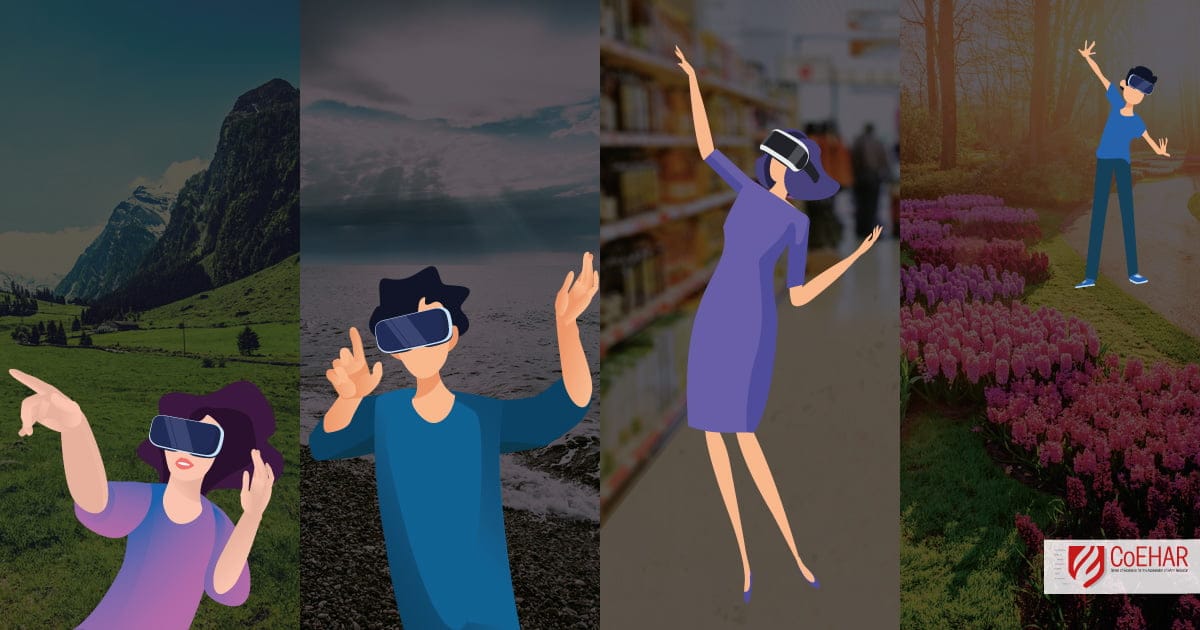A Systematic Review conducted by the researchers of the University of Catania and COEHAR suggests that Immersive Virtual Reality can be used to treat symptoms related to the spectrum of schizophrenia.
Catania, 31 august 2020– Virtual reality has undoubted advantages, such as versatility,reproducibility, standardization of treatments, adaptability on patients’ needs, rapidity,effectiveness, long-term persistent results even after a few sessions, greater patient motivation. It should also be emphasized that immersive virtual reality allows effective drug-free interventions and, therefore, without side effects for patients, even in those resistant to normal drug therapies.
The researchers of the University of Catania and Coehar (Center of Excellence for the acceleration of Harm Reduction), have recently published a Systematic Review, titled “Immersive Virtual Reality Applications in Schizophrenia Spectrum Therapy: a Systematic Review” inside the special issue of “Cyber Health Psychology and Psychotherapy: The Use of New Technologies in the Service of Mental Health” International Journal of Environmental Research and Public Health, leaded by Pasquale Caponnetto, Maria Signorelli and Marilena Maglia.
In this special issue belongs to the section “Mental Health” some of the technologies used in the clinical-psychological, psychotherapy, and mental healths field were analysed, including virtual reality, biosensors, artificial intelligence, and affective computing, with the aim of understanding how technological progress and the emergence of new technologies can generate value within the psychological panorama.
VIRTUAL REALITY
Virtual Reality is a fully immersive computer simulated experience consisting of the development of a three-dimensional virtual environment. A subject can interact with the environment through inputs given via a controller or keyboard. Several clinical studies have demonstrated its efficacy in the treatment of post-traumatic stress disorder, anxiety disorder and specific phobias.
The aim of this Systematic Review is to focus specifically on immersive virtual reality therapies for schizophrenia spectrum disorders providing an up-dated view of the current spectrum of available therapeutic techniques.
To better understand the implications of the research, we need to define two types of approaches: the first one is Immersive Virtual Reality, that uses a head-mounted display which allows complete immersion and interactivity of the patient in the virtual environment. The second one is the non-Immersive or Interactive Virtual Reality, where the patient is placed in front of an ordinary display re-producing a virtual environment. This approach lacks the immersive features of the first one.
Although there are no specific studies, due to the innovative nature of the approach, the available evidence seems to suggest its effectiveness and versatility in successfully treating various positive and negative symptoms related to schizophrenia spectrum disorders.
VIRTUAL REALITY AND SMOKING CESSATION
In a recent COEHAR study, researchers enrolled 40 young smokers between their twenties and thirties not motivated to quit and invited them to evaluate their motivation to quit after been subjected to three different types of motivational stimuli: a packet of cigarettes containing shocking images; a brief movie showing pulmonary effects of smoking and a virtual reality period based on the progression of smoking- related illness.
Compared with the first assessments, all stimuli were significant in improving the motivation for smoking cessation. The difference between the stimulus of the packet of cigarettes containing shocking images and the movie compared to the one of the virtual reality is significant: the application to virtual reality would appear to greatly increase the motivation to smoking cessation.
DELUSIONS AND PARANOIA
Persecutory delusions derive from inconsistent threat beliefs that activate safety-seeking behaviors aimed to avoid anxiogenic situations. Two randomized controlled trials demonstrated how these virtual reality therapeutic results were still consistent after therapy in dealing with real-world situations. In researchers’ opinion, it is necessary to expand the samples and make a trial confronting the virtual reality cognitive behavior therapy with the classic cognitive behavior therapy.
AUDITORY VERBAL ALLUCINATIONS
The auditory verbal hallucinations represent one of the most frequent and disabling symptoms associated with psychosis. In a randomized partial cross-over trial, patients affected by pharmacologically resistant schizophrenia treated with virtual reality showed significant improvements in the disease severity, depressive symptoms and life quality. Patients’ improvements remained stable over-time and even got better at the 3-month follow-up, showing that the coping strategies learned during VR therapy applied to everyday life brought further improvements and enhanced life quality of these patients. Through immersive VR, the patients can explore and experiment emotions in a safe controlled environment and learning how to better regulate them modifying their relationship with persecutory voices.
COGNITIVE DEFICITS
The cognitive functions in people with schizophrenia spectrum disorders are often compromised. Two clinical trials conducted by La Paglia used the virtual reality to have patients executing tasks in four different environments, including a park, a supermarket, a beach and a valley. After 10 sessions, the group treated with the virtual reality therapy showed better reduction of number of errors and tasks execution time, combined with an increased rules’ compliance and sustained attention.
SOCIAL SKILLS
In a single randomized controlled trial conducted with 91 participants with schizophrenia spectrum disorders, the virtual reality therapy led to greater improvements in the conversational skills of the patients and also induced greater assertiveness and motivation to treatment.
In conclusion, current evidence does not yet allow to establish whether virtual reality treatments are better than conventional ones. Due to the lack of studies on the argument, new ones on larger samples are needed to confirm the promising results obtained so far.




